Author Archives: Amy Stone
October 18, 2011 by Amy Stone
Occupy Sukkot/Occupy Judaism – Would you go to jail for this?
Down at Zuccotti Park (aka Liberty Plaza) we had the choice of the sukkah we go to and the sukkah we don’t go to. It was the day after the Occupy Wall Street protesters refused to move out of the park for a sanitation department cleanup. The occupiers cleaned up the park and the establishment backed down, at least for the moment. What better place to celebrate Shabbat-Sukkot.
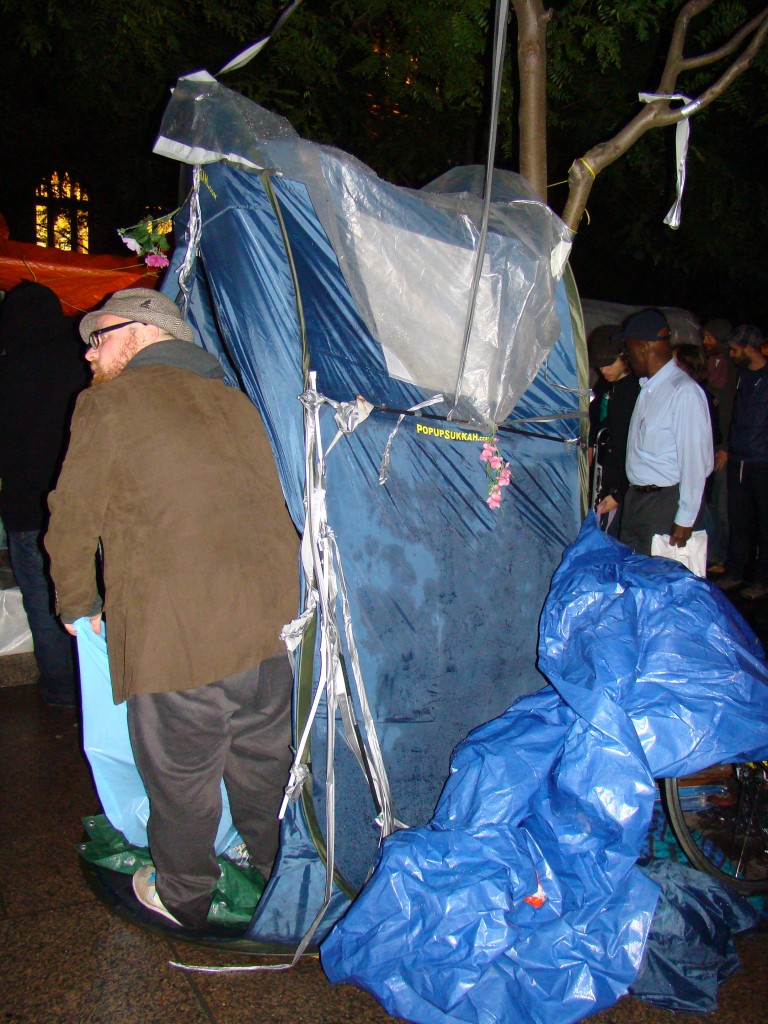
Photo by Amy Stone
Before the cleanup showdown, Daniel J. Sieradski, the “post-Orthodox” organizer behind the Kol Nidre service next to the park, had assembled a Chabbad popup sukkah in Zuccotti Park. The halachic hovel was unfit for man or beast – especially in high winds and rain. Friday evening Sieradski was vacating, while a few yards away, Jews for Racial and Economic Justice (JFREJ) were getting ready to celebrate Shabbat and Sukkot under a sturdy non-halachic shelter. “Shake, shake, sniffy, sniffy” Participants were instructed to shake the lulav and sniff the etrog.
Then the cops moved in. No tents allowed. What is this, anti-Semitism? (Just joking – haha.) What about that tent over there? Policewoman explains that the huge tarp attached to a few trees is “not a tent. It’s an umbrella.” The guidelines are obviously in flux. The head of JFREJ, Marjorie Dove Kent, takes a hands up/hands down vote (fingers wiggling OWS vote style) on whether we want to risk arrest.
We barely have our Judaism or our politics together but the majority definitely does not want to risk arrest on this issue at this time.
- 1 Comment
October 12, 2011 by Amy Stone
Kol Nidre Alongside Occupy Wall Street

Photo by Amy Stone
You’ve got to be attracted to a call to a Yom Kippur service next to the Occupy Wall Street protesters, especially when the Facebook invite starts with a quote from Rabbi Abraham Joshua Heschel:
“Prayer is meaningless unless it is subversive, unless it seeks to overthrow and to ruin the pyramids of callousness, hatred, opportunism, falsehoods.”
The weather and the police cooperated, and at Friday’s Shabbat Kol Nidre, a crowd estimated at 700 gathered next to Zuccotti Park (aka Liberty Plaza), OWS home base a few blocks from Wall Street.

Photo by Amy Stone
The impassioned and knowledgeable leaders (one woman, several men) conducted the egalitarian service using the new Conservative high holiday prayer book, with 100 copies lent by the Rabbinical Assembly (the organization of Conservative rabbis) and numerous photo copies. The service took place on the plaza in front of global financial services firm Brown Brothers Harriman. A large Bank of America presence on one side, smoothie and halal trucks on another, just beside Zuccotti Park. It felt like davening next to the circus with the constant drumming of the OWS musicians.
Same for the Yom Kippur sermon of Getzel Davis, a fourth year rabbinical student at the “transdenominational” Hebrew College outside Boston. Davis opened up with the myth that Yom Kippur is the day we’re forgiven for worshipping the golden calf. Nothing like absorbing the message of a sermon by all assembled repeating every word. (more…)
- 3 Comments
September 22, 2011 by Amy Stone
Out and Ordained – An Update
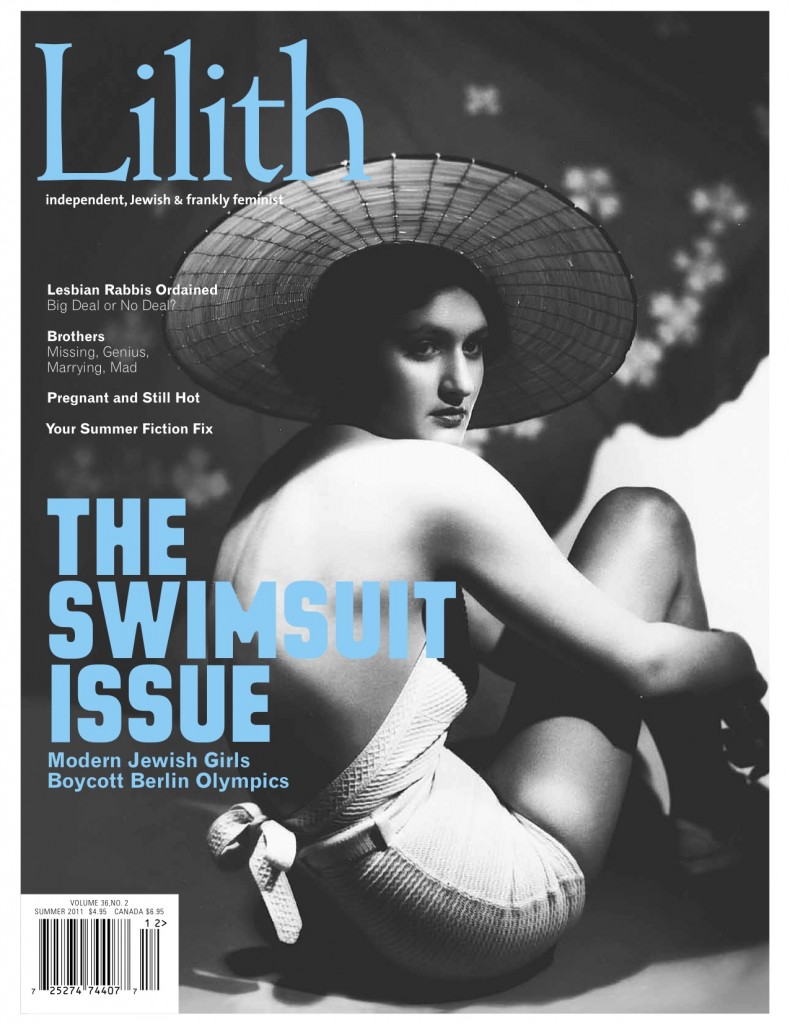 Before updating Lilith readers on the story “Out and Ordained,” in Lilith’s current issue, a few corrections to the published piece:
Before updating Lilith readers on the story “Out and Ordained,” in Lilith’s current issue, a few corrections to the published piece:
–While Rachel Isaacs is the first openly gay rabbinical student to be ordained by the Jewish Theological Seminary, the seminary’s first openly gay rabbinical student is Aaron Weininger. He entered as a first-year rabbinical student in the fall of 2007. Isaacs entered as a third-year student in 2008.
–Rabbinical School Dean Rabbi Daniel Nevins’ comment that gay and lesbians number no more than “a good minyan” referred to the JTS Rabbinical School, not to the Conservative rabbinate as a whole.
–American Jewish University is an independent institution not affiliated with any one branch of Judaism, although the Ziegler School of Rabbinic Studies, housed within AJU, is Conservative.
As fate would have it, New York State’s legalizing same-sex marriage came shortly after the Jewish Theological Seminary’s ordination of its first openly gay rabbinical student – putting New York’s Conservative rabbis on the line on performing gay and lesbian marriages.
The 2006 Conservative movement law committee responsum allowing gay/lesbian rabbis and cantors within Conservative Judaism also permits Conservative rabbis to perform same-sex commitment ceremonies – if they want to. Proof that homophobia is alive and well, The New York Times article on Conservative rabbis featured one New York rabbi as shamelessly saying he’s never performed a same-sex marriage in his nearly 40 years in the pulpit and is not about to start now. Overtly sexist and racist actions are now taboo, not to mention illegal, but homophobic leaders can still exercise their prejudices.
A measure of the homophobic atmosphere within the Jewish Theological Seminary and beyond during the Conservative movement law committee’s 1991-92 hearings on homosexuality is the 1992 responsum clause against “instigating witch hunts” authored by Rabbi Elliot Dorff, AJU rector and current chairman of the law committee. Meant to protect gays as part of the responsum forbidding homosexual rabbis, Dorff said he “came to regret it – a lot.” He explained the wording was meant as “a flourish” to avoid “any kind of super investigative commission,” but the result was that gay and lesbian rabbinical students and rabbis were the victims of witch hunts instigated by outsiders. (more…)
- 4 Comments
June 29, 2011 by Amy Stone
Today we’re all gay…
Today we’re all gay…
 Yes, yes, we’re still in the afterglow. The dinosaurs of Albany, more known for corruption and dysfunction, have stunned and delighted us by making same-sex marriage legal in the Empire State.
Yes, yes, we’re still in the afterglow. The dinosaurs of Albany, more known for corruption and dysfunction, have stunned and delighted us by making same-sex marriage legal in the Empire State.
The 33-to-29 victory in the State Senate came from Governor Andrew Cuomo’s determination to give gays civil rights – pulled off with strict Democrat party discipline and inducements by mega-wealthy Republican supporters to get a few Republicans to break rank and vote for gay marriage.
The road to gay marriage was rocky – but no rockier than Conservative Judaism’s fraught path in finally deciding to allow same-sex commitment ceremonies.
The split vote in Albany was similar to the split in Conservative Judaism’s law committee. In two opposing responses to Jewish law before the law committee, 13 to 12 voted in favor of the response allowing gay commitment ceremonies (along with gay rabbis and cantors) and 13 to 12 voted for an opposing response (one rabbi voted both ways). Part of the rabbinic reasoning favoring gay marriage was that Judaism does not advocate celibacy over loving relations.
When a sampling of Conservative Jews was polled back in 2007, a majority, like the recent poll of Americans, favored letting gays publicly avow their love. The more than 5,000 Conservative Jews who responded were fine on gay marriage and gay clergy but – traditional in some respects – a majority opposed rabbis performing marriage ceremonies uniting a Jew (straight or gay) with a non-Jew. So… gates open for Jewish gays and lesbians to be joined by a rabbi (gay or straight) in the interest of family values.
As for the Albanyians – not even the dysfunctional state legislature can pass a law coming down firmly on both sides so thank you Governor Cuomo for pushing this civil rights issue into law. But in a move that Conservative rabbis might appreciate, a few pivotal paragraphs in the bill helped swing the vote by protecting religious institutions from law suits and government penalties if they refuse to perform same-sex marriages. Reads like a page from the Conservative law committee decision.
Happy ending in New York: now Conservative Judaism’s Conservative rabbis who feel comfortable with gay commitment can perform both the religious ceremony and, with the powers invested in them by the State of New York, legally unite gay and lesbian couples.
Amen.
- 1 Comment
June 24, 2011 by Amy Stone
Missing Esther Broner
I’ve just come home from Esther Broner’s funeral.
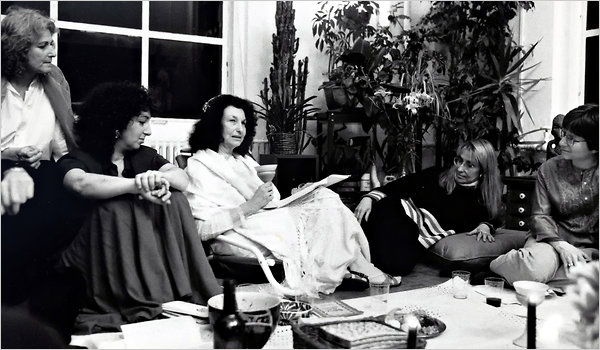
E. M. Broner, center, leading a women's seder (New York Times)
Esther got the A-list of speakers at her funeral. It was the list she put together right after her beloved husband, Robert, died exactly one year and one day before her. (With those close to her describing her slowly succumbing to failing heart and lungs, I imagine her dying of a broken heart.)
Nephew, children and the famous feminists who were part of her feminist seders over the years – Iconic Feminists Gloria Steinam and Letty Cottin Pogrebin – along with writer Vivian Gornick, American-Israeli Knesset trouble maker Marcia Friedman, longtime local NBC anchor woman Carol Jenkins and daughter, rabbis from Esther Broner’s beloved B’nai Jeshurun Synagogue, and more, all crowded into the Plaza Jewish Community Chapel on Manhattan’s Upper West Side, a few blocks from her tiny apartment.
Her nephew hit just the right note on his “crazy New York aunt,” whom he was amazed to find was famous. His magic aunt, a witch, a good witch, with the great cackling laugh.
The women privileged to be in Esther’s feminist seder circle over going back to 1976 lovingly and gratefully told of her rituals created for them in hours of need.
Words of wisdom: Don’t let the facts get in the way of a good story line. Don’t brush away pamphleteers. Show them respect; take what they’re giving out.
The healing generosity of Esther: Letty telling how when she was totally overwhelmed with all she had taken on, Esther had her lie down, arms outstretched on a huge piece of butcher paper. Esther then outlined Letty’s body with a magic marker and used a feather to brush away the stress from the outlined body. She had Letty repeat three times, “I have boundaries; I can say no.” (Read Letty’s entire speech in the Forward.)
Vivian Gornick spoke of how when she was blocked in her writing, Esther told her to come over and bring two pages. She kept coming over every week with two more pages until the work was done.
Gloria, thin, serious in black, modestly putting her palms together in a Buddhist greeting of respect. She described her shared grief with Esther after the death of Marilyn French, author of The Women’s Room and their laughing over The New Yorker cartoon of a man with briefcase selling closure.
Memories of Esther’s supply of magic sparkling toy wands and feather rituals. The queen of ritual starting with “The Women’s Haggadah,” written with Naomi Nimrod and published in Ms. Magazine in 1977.
Appreciation of Esther as wife, mother, novelist, poet, fighter for good causes, and weaver of magic rituals.
I remember how surprised I was when I interviewed her for the Lilith article on Feminist Funerals, amazed that she seemingly hadn’t given thought to the final rituals of death. But once she got started, what visions. She wanted lamentations to return to funeral rituals. She imagined a chorus of women tracing the deceased’s matrilineage — “not just bereaved women quietly weeping in the front rows of the funeral parlor.”
Yes, that was what was missing. Letty quoted Esther as writing on a card shared with the Seder Sisters this year: “Esther Broner: Once she had a shadow. The shadow has been sheared off. Now there remains a trunk of memories of you.” Maybe that was her final hint of what a suitable ritual might be. If only the chorus of women had dug into the trunk other than verbally.
If only one woman had had the courage to give throat to the ululating cry of grief.
Surely the rest of us silent women would have had the courage to join in this ancient soul-searing sendoff.
- No Comments
February 7, 2011 by Amy Stone
Feminists in Focus: Reporting back from the New York Jewish Film Festival ‘Yolande: An Unsung Heroine’ – the Egyptian Jewish spy – and ‘Red Shirley’
At the 20th New York Jewish Film Festival, presented by The Jewish Museum and the Film Society of Lincoln Center (through Jan. 27).
“Yolande: An Unsung Heroine”
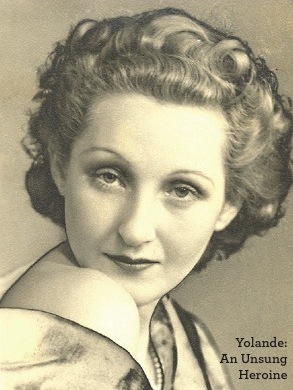 Well before Mubarak, when Egypt had a king, and pashas and spies gathered on the balcony of Cairo’s Grand Continental Hotel, Yolande Gabai de Botton was gathering intelligence for the embryonic Jewish State.
Well before Mubarak, when Egypt had a king, and pashas and spies gathered on the balcony of Cairo’s Grand Continental Hotel, Yolande Gabai de Botton was gathering intelligence for the embryonic Jewish State.
The French-educated child of a Jewish-Egyptian family, Yolande was the beautiful blonde internationalist, risking both her son’s life and her own as a spy, operating a network of informers including an agent within the Muslim Brotherhood. Her contacts were so good that she got the Arab League minutes before the Arab League secretary.
Yolande used her work as a journalist as cover for reporting on Cairo’s power elite – right up to the king — for Israel’s pre-state de facto government, the Jewish Agency. She reported directly to Teddy Kollek, the future long-time mayor of Jerusalem, back when he headed intelligence for the Jewish Agency. (more…)
- 1 Comment
January 26, 2011 by Amy Stone
Feminists in Focus: Reporting back from the New York Jewish Film Festival ‘Grace Paley: Collected Shorts’ and ‘As Lilith’
At the 20th New York Jewish Film Festival, presented by The Jewish Museum and the Film Society of Lincoln Center (through Jan. 27).
“Grace Paley: Collected Shorts”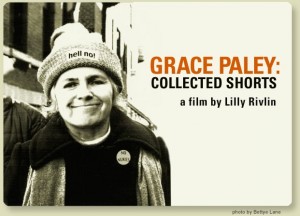
How does a Jewish feminist filmmaker celebrate success, long time a-coming? In the case of Lilly Rivlin, generously.
In black boots and glittering red jacket, Rivlin was the proud mother, making sure everyone involved with “Grace Paley: Collected Shorts” got credit. She turned the New York Jewish Film Festival post-screening Q&A into a moment of oral history, calling on anyone in the audience with a story to tell about Grace Paley to share it. And they did.
The 75-minute film. completed in 2010, is a valentine to the beloved writer, anti-war activist, wife and mother who died of breast cancer in 2007 at the age of 84. A film needs tension, Rivlin said during the post-film discussion, as reason for including writer-critic Vivian Gornick’s crack that Paley was no feminist.
Aside from that one remark, there’s no tension, just appreciation in interviews with political activists, writers, past students at Sarah Lawrence, her second husband, her daughter. Best of all is the diverse footage of Paley speaking for herself and in action. There’s the infamous PEN writers’ meeting chaired by Norman Mailer. The man shamelessly relegated women to the sidelines while elevating then-Secretary of State George Shultz under Reagan to center stage. Of course Paley was part of the women’s protest. (more…)
- 2 Comments
January 21, 2011 by Amy Stone
Feminists in Focus: Reporting back from the New York Jewish Film Festival 'The Klezmatics: On Holy Ground'
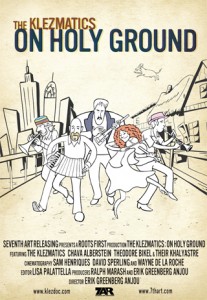 At the 20th New York Jewish Film Festival, presented by The Jewish Museum and the Film Society of Lincoln Center (through Jan. 27).
At the 20th New York Jewish Film Festival, presented by The Jewish Museum and the Film Society of Lincoln Center (through Jan. 27).
For any woman musician who’s fantasized about being the only babe in the band, “The Klezmatics: On Holy Ground” is a cautionary tale not to be taken lightly.
The Klezmatics describe themselves as a dysfunctional family. In a music industry falling apart, they went from winning a Grammy to firing the agent who helped make it happen, to seeing their record label go out of business, the office replaced by a methadone center. They’ve gone from being one of the first neo-klezmer bands back in the ‘80s to bringing the music back to Germany and Poland and they’ve performed before capacity audiences at Town Hall in New York City and Walt Disney Concert Hall in L.A. They’re in their glory on a big stage with an expanded band, Oriental carpets covering the floor and a starry night backdrop behind them.
Members come and go, including original fiddler Alicia Svigals, but some of the original founders are still with the band after 24 years. All this is chronicled by filmmaker Erik Greenberg Anjou (“A Cantor’s Tale” 2005), who followed the band’s highs and lows for more than three years. (more…)
- No Comments
January 17, 2011 by Amy Stone
Feminists in Focus:Reporting back from the New York Jewish Film Festival ‘My So-Called Enemy’ and ‘The Human Resources Manager’
At the 20th New York Jewish Film Festival presented by The Jewish Museum and the Film Society of Lincoln Center (through Jan. 27).
 Don’t expect a feel-good movie from “My So-Called Enemy” – the documentary following Jewish Israeli and Palestinian teen-age girls in the U.S. for a 10-day “Building Bridges for Peace” program back in 2002.
Don’t expect a feel-good movie from “My So-Called Enemy” – the documentary following Jewish Israeli and Palestinian teen-age girls in the U.S. for a 10-day “Building Bridges for Peace” program back in 2002.
Director Lisa Gossels has dedicated a chunk of her life to following six of the 22 girls to the leadership retreat in New Jersey then back home to Tel Aviv, Haifa, East Jerusalem and the West Bank over the next seven years.
The 90-minute documentary opens with urgent texting between Jewish Israeli Gal and Christian Palestinian Rezan. It ends with their determination to remain connected as they stand dwarfed by a towering cement security wall separating Rezan’s village from East Jerusalem. Gal, the pro-Palestinian rebel in her religious family, has become a sergeant in the Israeli army. She changed out of her uniform for the meeting.
Not a pretty picture, but not without hope.
Some of girls bond their first day in New Jersey over the weirdness of American broccoli pizza. In a joyous dance scene, some of the Jewish girls overcome their fear of the kaffiya’s symbolism, with one girl seductively waving it as she undulates to the music. Quite a moment since they’re all coming out of the bloody violence on all sides of the Second Intifada. (more…)
- No Comments
January 13, 2011 by Amy Stone
Feminists In Focus: ‘Mahler on the Couch’ Without Jewish Guilt at the New York Jewish Film Festival
 How refreshing to have the New York Jewish film festival open on Wednesday (Jan. 12) with an offering where the guilt is not Jewish. In “Mahler on the Couch,” the guilt emanates from the male ego of a musical genius (Gustav Mahler) suppressing the musical creativity of his wife – the much younger and super sexual Alma.
How refreshing to have the New York Jewish film festival open on Wednesday (Jan. 12) with an offering where the guilt is not Jewish. In “Mahler on the Couch,” the guilt emanates from the male ego of a musical genius (Gustav Mahler) suppressing the musical creativity of his wife – the much younger and super sexual Alma.
Mahler has been driven to the couch of Sigmund Freud by a love letter to his young wife from the even younger Walter Gropius, the future creator of Bauhaus.
Yes, Freud was Jewish. Mahler converted from Judaism to Catholicism. Several marriages and many affairs later, Alma Mahler Gropius Werfel was the Nazi-loving wife of a Jew who escaped with her from Vienna to Hollywood. But we’re getting way, way beyond the scope of the film.
How delightful to come in from the January snows of New York to the lushness of Vienna in the 1900’s when everything was being invented – psychoanalysis, Secessionist art and architecture, Mahler’s and Schoenberg’s music. When it was too early to worry about the Fascists and the Nazis or even World War I. (more…)
- No Comments
 Please wait...
Please wait...